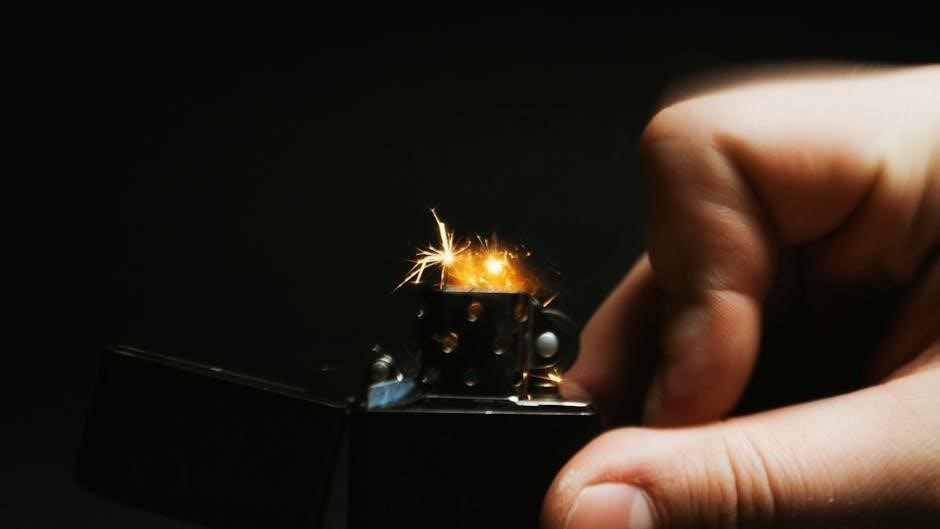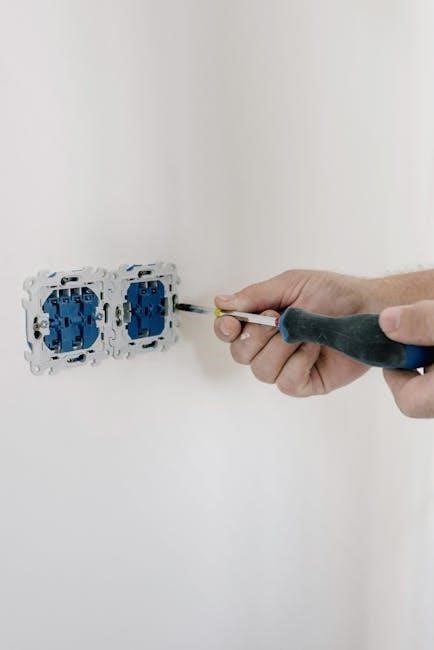The ignition coil wiring diagram manual provides a detailed guide for installing, troubleshooting, and understanding ignition systems. It includes step-by-step instructions, electrical connections, and system operation basics.
1.1 Overview of Ignition Coil Functionality
The ignition coil is a critical component in a vehicle’s ignition system, responsible for generating the high voltage needed to create sparks in the spark plugs. It operates by using electromagnetic induction, where an alternating current in the primary circuit induces a high-voltage current in the secondary circuit. This process ensures the spark plugs fire correctly, igniting the fuel-air mixture in the engine’s combustion chambers. Proper functionality of the ignition coil is essential for engine performance, fuel efficiency, and reducing emissions. Understanding its operation is key to diagnosing and repairing ignition system issues, as outlined in the wiring diagram manual.
1.2 Importance of Wiring Diagrams in Ignition Systems
Wiring diagrams are essential for understanding and working with ignition systems, providing a visual representation of electrical connections and components. They guide the installation, troubleshooting, and maintenance of ignition coils, ensuring proper connections and functionality. Diagrams help identify issues like faulty wiring or incorrect connections, which can cause engine misfires or poor performance. By following a wiring diagram, technicians can accurately diagnose problems, such as error codes related to ignition coils, and perform repairs efficiently. These diagrams also prevent wiring errors that could lead to system failures or safety hazards, making them indispensable for both professionals and DIY enthusiasts working on ignition systems.

Understanding Ignition Coil Components
The ignition coil consists of primary and secondary windings, a core, and a spark plug connection. It transforms battery voltage into high voltage for fuel ignition.
2.1 Primary and Secondary Circuits Explained
The ignition coil operates using two circuits: the primary and secondary. The primary circuit connects to the battery and ignition switch, controlling the flow of current. When the ignitionswitch activates, current flows through the primary winding, creating a magnetic field.Interrupting this flow generates a high-voltage surge in the secondary circuit, which is then directed to the spark plug. The secondary circuit amplifies the voltage to the levels needed for fuel ignition. Understanding these circuits is crucial for diagnosing and repairing ignition system issues, ensuring proper spark generation and engine performance.
2.2 Ignition Coil Construction and Operation
An ignition coil consists of two main windings: the primary and secondary. The primary winding is connected to the battery and ignition switch, while the secondary is insulated and wound thousands of times around a laminated steel core. When the ignition is activated, current flows through the primary winding, creating a magnetic field. Interrupting this current causes the magnetic field to collapse, inducing a high voltage in the secondary winding. This voltage is then directed to the spark plug, creating the necessary spark for combustion. Proper insulation and construction ensure efficient energy transfer and prevent electrical interference or short circuits, making the coil a critical component in engine operation.
2.3 Role of Spark Plugs in the Ignition System
Spark plugs are essential components in the ignition system, responsible for igniting the fuel-air mixture inside the engine’s combustion chambers. Connected to the ignition coil’s secondary circuit, they receive the high voltage necessary to generate a spark. The spark plug’s electrodes create a gap where the electrical discharge occurs, initiating combustion. Properly functioning spark plugs ensure efficient engine performance, preventing misfires and improving fuel efficiency. Over time, spark plugs can foul or wear out, requiring regular inspection and replacement. Their condition directly impacts the ignition system’s effectiveness, making them a critical maintenance point for optimal engine operation and reliability.

Tools and Materials Required
Essential tools include a multimeter, wire strippers, pliers, and screwdrivers. Materials needed are high-quality wires, connectors, and spark plug wires. A detailed wiring diagram manual is crucial for accuracy and safety during installation and troubleshooting processes.
3.1 Essential Tools for Wiring an Ignition Coil
Key tools for wiring an ignition coil include a digital multimeter, wire strippers, pliers, screwdrivers, and spark plug wires. A multimeter is crucial for diagnosing electrical issues, while wire strippers ensure clean, safe connections. Pliers and screwdrivers aid in securing wires and connectors. High-quality spark plug wires are necessary for proper voltage transmission. Additionally, a wiring diagram manual provides clear guidance, ensuring accurate connections. Proper tools prevent damage to components and ensure reliable ignition system performance. Always use insulated tools to handle high-voltage components safely; Having the right tools on hand streamlines the process and minimizes potential errors during installation or troubleshooting.
3;2 Importance of a Multimeter for Diagnostics
A multimeter is a vital tool for diagnosing ignition coil wiring issues. It measures voltage, resistance, and continuity, helping identify faulty connections or components. By checking the primary and secondary circuits, you can detect opens, shorts, or resistance imbalances. This tool is essential for troubleshooting error codes like P0351-P0354, which indicate ignition coil circuit problems. Using a multimeter ensures accurate diagnostics, preventing misdiagnosis and unnecessary repairs. Regular use helps maintain system reliability and performance. Always follow proper testing procedures to avoid damage to the ignition system or the multimeter itself.
3.3 Wiring Diagrams and Manuals
Wiring diagrams and manuals are essential resources for understanding and working with ignition coil systems. They provide detailed visual representations of connections and components, helping users identify and resolve issues efficiently. Manuals often include step-by-step instructions for installation, troubleshooting, and maintenance. These resources are crucial for diagnosing error codes, interpreting circuit layouts, and ensuring proper connections. By referencing wiring diagrams, users can avoid incorrect connections and ensure system reliability. Many manufacturers offer downloadable PDF versions of these manuals, making them easily accessible for DIY enthusiasts and professionals alike. They are indispensable for maintaining and repairing ignition systems effectively.

Step-by-Step Installation Guide

Install the ignition coil by disconnecting the battery, accessing the coil, and unplugging the primary wiring. Mount the new coil, reconnect wires, and restore power to test functionality.
4.1 Preparing the Vehicle for Ignition Coil Installation
Before installing the ignition coil, ensure the vehicle is parked on a level surface and the engine is cool. Disconnect the battery to prevent accidental engine start. Gather tools like wrenches, screwdrivers, and a multimeter for diagnostics. Locate the ignition coil, spark plugs, and associated wiring. Refer to the vehicle’s service manual for specific locations and precautions. Remove any components obstructing access to the ignition coil. Ground the vehicle to prevent static discharge, which could damage the new coil. Double-check the wiring diagram to confirm connections and ensure all safety protocols are followed to avoid injury or damage.
4.2 Connecting the Ignition Coil to the Battery
Connect the ignition coil’s positive terminal to the vehicle’s 12V battery using a heavy-duty wire. Ensure the connection is secure and free from corrosion. The negative terminal of the coil should be linked to the ignition switching unit or module. Use a multimeter to verify the battery voltage is stable at 12V. Avoid crossing wires with high-voltage components to prevent interference. Double-check the wiring diagram to confirm polarity and connections. Proper insulation and routing of wires are crucial to prevent damage or short circuits. Test the circuit with a multimeter to ensure continuity and absence of resistance before powering up the system.
4.3 Linking the Ignition Coil to the Spark Plug
Connecting the ignition coil to the spark plug is crucial for generating the spark needed to ignite the fuel mixture. Start by identifying the spark plug location and tracing the spark plug wire. Ensure the wire is in good condition, free from cracks or wear, to prevent misfires. Attach the spark plug wire to the ignition coil’s output terminal, referring to the wiring diagram for correct connections. Use a multimeter to verify continuity and proper grounding. Route the spark plug wire away from high-voltage components to avoid interference. Secure all connections tightly and apply dielectric grease to protect the boots from heat and moisture. Always disconnect the battery before working and use insulated tools for safety. Finally, inspect the spark plug and ensure it is properly seated and torqued to specifications.
4.4 Finalizing the Wiring Connections
After connecting the ignition coil and spark plug, ensure all wiring connections are secure and properly insulated. Double-check the wiring diagram to confirm accuracy and avoid cross-connections. Use a multimeter to verify continuity and resistance in the circuit, ensuring no short circuits or open connections. Apply dielectric grease to spark plug boots for protection against heat and moisture. Secure all wires with cable ties to prevent chafing or damage from moving components. Test the ignition system by starting the engine and checking for smooth operation and consistent spark. If any issues arise, refer back to the wiring diagram to troubleshoot and correct connections.

Troubleshooting Common Issues
Identify ignition coil issues like engine misfires or poor fuel efficiency. Use a multimeter to check for faulty wiring or damaged circuits. Refer to error codes and wiring diagrams for precise diagnostics and repairs.
5.1 Identifying Common Ignition Coil Problems
Common ignition coil issues include engine misfires, poor fuel efficiency, and loss of spark. Look for symptoms like rough idling, decreased power, or illuminated error codes. Faulty wiring, damaged insulation, or internal coil failures are frequent culprits. Use a multimeter to test resistance and voltage levels, ensuring they match manufacturer specifications. Check for DTCs related to primary or secondary circuits, such as P0351-P0354, which indicate specific coil or wiring faults. Visual inspections for cracks, corrosion, or loose connections can also help pinpoint issues. Always refer to wiring diagrams for accurate diagnostics and repairs.
5.2 Understanding Error Codes Related to Ignition Coils
Modern vehicles use error codes to diagnose ignition coil issues. Codes like P0351-P0354 indicate specific problems in the primary or secondary circuits of the ignition coil. These codes help identify which coil or wiring is faulty. For example, P0351 refers to the primary circuit of coil A, while P0354 points to issues with coil D. Using a multimeter, technicians can test resistance and voltage levels to confirm the fault. Always refer to the wiring diagram for accurate troubleshooting. Addressing these codes promptly prevents further engine damage and ensures proper ignition system function.
5.3 Checking for Faulty Wiring Connections
Identifying faulty wiring connections in the ignition system is crucial for proper functionality. Start by consulting the wiring diagram to locate each connection point. Use a multimeter to test for continuity and voltage drops across wires and connectors; Look for signs of wear, corrosion, or damage in the wiring harness. Loose connections or broken wires can disrupt the ignition coil’s operation, leading to misfires or poor engine performance. Ensure all terminals are securely fastened and free from debris. Regular inspections can prevent issues before they escalate, maintaining reliable ignition system operation and overall vehicle efficiency.

Maintenance and Upkeep
Regular inspections ensure optimal ignition system performance. Clean or replace spark plugs as needed to maintain proper combustion. Check wiring connections to prevent wear-related issues.
6.1 Regular Inspections for Optimal Performance
Regular inspections are crucial for maintaining the ignition system’s efficiency. Start with a visual check of the wiring and connections, ensuring they are secure and free from damage or corrosion. Use a multimeter to test the resistance of the ignition coil, comparing it to the manufacturer’s specifications. Inspect spark plugs for wear or fouling, cleaning or replacing them as needed. Check for any error codes related to the ignition system using a diagnostic tool. Addressing issues early prevents misfires and poor engine performance. Grounding checks are also essential to ensure proper electrical flow. Regular maintenance ensures reliable ignition system operation and prevents costly repairs.
6.2 Cleaning and Replacing Spark Plugs
Cleaning and replacing spark plugs is essential for maintaining engine performance. Start by disconnecting the battery to prevent electrical shocks. Remove the spark plug wires and use a spark plug socket to extract the plugs. Clean dirty plugs with a wire brush or replace them if worn. Ensure new plugs are properly gapped and tightened to the manufacturer’s specifications. Reinstall the wires securely and reconnect the battery. Test the engine to ensure smooth operation. Regular spark plug maintenance prevents misfires and enhances fuel efficiency, keeping your ignition system functioning optimally.
6.3 Preventative Measures to Avoid Wiring Issues
To prevent wiring issues, ensure ignition coil wires are properly routed away from high-heat sources and moving components. Use high-quality connectors and insulation to protect against wear and corrosion. Regularly inspect wires for damage or wear and replace them if necessary. Avoid overloading circuits and ensure all connections are secure. Use a multimeter to test wiring resistance and identify faults early. Grounding systems should be checked for cleanliness and proper contact to prevent voltage leaks. Finally, consult your wiring diagram manual to ensure all connections align with manufacturer specifications, ensuring reliable ignition system performance and safety.

Advanced Wiring Configurations
Explore advanced wiring setups for multiple ignition coils, high-performance vehicles, and specialized racing engines. Learn sequential ignition control and dwell timing adjustments for optimal spark delivery.
7.1 Wiring Diagrams for Multiple Ignition Coils
Wiring diagrams for multiple ignition coils simplify complex systems by assigning each coil to a specific spark plug. Sequential ignition control reduces wiring complexity, ensuring precise spark timing. For high-performance vehicles, diagrams often include individual coil packs with dedicated power and ground connections. Proper insulation and routing of wires are crucial to avoid interference. Diagnostic steps like multimeter testing and DTC analysis help troubleshoot common issues. Advanced configurations may require additional components like ignition modules or capacitors. Always refer to the vehicle’s manual for specific wiring layouts and safety precautions.
7.2 Configurations for High-Performance Vehicles
High-performance vehicles often require advanced ignition coil configurations to optimize power and efficiency. Sequential ignition systems use individual coil packs for each spark plug, reducing energy loss and improving spark consistency. Wiring diagrams for these setups typically include dedicated power and ground connections, as well as capacitors or ignition modules to store and release energy efficiently. Proper shielding and routing of wires are essential to prevent electromagnetic interference. For high-RPM applications, specialized coils with faster charging times are recommended. Always consult the vehicle’s manual or a certified technician for precise wiring layouts tailored to your engine’s specifications.
7.3 Specialized Wiring for Racing Engines
Racing engines require specialized ignition coil wiring to handle high RPM and extreme conditions. These configurations often involve multiple coils, capacitors, and advanced ignition modules for precise spark timing. Wiring diagrams for racing setups emphasize high-gauge wires to reduce resistance and heat buildup. Shielding is critical to prevent electromagnetic interference from high-performance components. Racing ignition systems may also incorporate coil-on-plug designs or distributor-less systems for better reliability. Proper grounding and isolated power sources are essential to maintain consistent spark energy. Always follow manufacturer guidelines for specific racing applications to ensure optimal performance and durability under extreme stress.

Safety Precautions and Best Practices
Always wear protective gear and ensure the vehicle is grounded. Avoid high voltage exposure and use insulated tools. Proper grounding prevents electrical shocks and system damage.
8.1 Safety Tips When Working with High Voltage
When working with high voltage in ignition systems, always disconnect the battery to prevent accidental engine start. Use insulated tools to avoid electric shocks. Ensure the vehicle is properly grounded to prevent static discharge. Wear protective gear, including gloves and safety goggles, to minimize risk. Never touch high-voltage components with bare hands, as even residual voltage can cause harm. Keep the work area dry to prevent conductivity. Be cautious of capacitors, as they can store dangerous charges. Always refer to the manual for specific safety guidelines. Safety should never be compromised when handling high-voltage ignition systems.
8.2 Proper Use of Tools and Equipment
Using the correct tools and equipment is crucial when working with ignition coil wiring. Always use insulated tools to handle high-voltage components to prevent electrical shocks. A multimeter is essential for diagnosing issues and measuring resistance or voltage. Ensure all tools are in good condition and suitable for the task. Properly ground the vehicle and tools to avoid static discharge. Use spark plug wrenches for secure connections and avoid damaging the threads. Follow the manual’s guidelines for tool usage and safety protocols. Using the right equipment ensures accurate and safe repairs, preventing damage to the system or personal injury.
8.3 Importance of Grounding in Ignition Systems
Proper grounding is essential for the safe and efficient operation of ignition systems. A well-grounded ignition coil ensures a stable electrical connection, reducing the risk of voltage fluctuations and component failure. Grounding prevents electrical noise and interference, which can disrupt spark plug firing and lead to engine misfires. It also protects against high-voltage arcing, safeguarding both the system and the technician. Ensure all ground wires are clean, secure, and free from corrosion. Proper grounding enhances system reliability, improves performance, and prevents potential safety hazards, making it a critical step in any ignition coil wiring installation or repair.
The ignition coil wiring diagram manual is essential for proper installation and troubleshooting. It guides through verifying the ignition system, testing the coil, and ensuring safety effectively.
9.1 Verifying the Ignition System After Installation
After installing the ignition coil, verify the system by checking all wiring connections for accuracy and ensuring proper grounding. Use a multimeter to test the coil’s resistance and voltage output. Start the engine and monitor for misfires or unusual sounds. Check spark plug wires for cracks and ensure they are securely connected. Refer to the wiring diagram to confirm all connections match the manual’s specifications. Properly functioning ignition systems will show consistent spark production and stable engine operation. Address any discrepancies immediately to prevent damage or performance issues.
9.2 Testing the Ignition Coil for Proper Function
Testing the ignition coil ensures proper function and reliability. Begin with a visual inspection for damage or wear. Use a multimeter to measure primary and secondary circuit resistance, comparing results to the manufacturer’s specifications. Check the coil’s voltage output while the engine is running. A functioning coil should produce a consistent spark at the spark plug. If spark is absent, test the coil’s primary and secondary circuits for opens or shorts. Ensure the coil is properly grounded and all connections are secure. Proper testing confirms the coil’s ability to generate the high voltage needed for combustion, ensuring optimal engine performance and preventing potential issues. Regular testing helps maintain reliability and efficiency.
9.3 Final Safety Inspection
A final safety inspection ensures the ignition system operates safely and efficiently. Verify all wiring connections are secure and properly insulated. Check for any signs of wear, damage, or heat damage on wires and components. Ensure the ignition coil is correctly grounded to prevent voltage leaks. Test the system with a multimeter to confirm proper voltage levels and resistance readings. Inspect spark plug connections for tightness and ensure no arcs or sparks are present during operation. Always handle high-voltage components with care, using appropriate tools and protective gear. A thorough inspection guarantees both performance and safety, preventing potential hazards and ensuring long-term reliability.

References and Further Reading
Consult official manufacturer manuals, online forums, and technical guides for detailed ignition coil wiring diagrams and troubleshooting tips. Resources include PDF manuals, repair guides, and specialized automotive websites.
10.1 Recommended Manuals and Guides
For comprehensive understanding, refer to official MSD Ignition and FuelTech manuals, which provide detailed wiring diagrams and installation steps. The IGN-1A Smart Coil User Guide is highly recommended for advanced configurations. Additionally, consult vehicle-specific repair manuals for accurate ignition system details. Online resources like PDF versions of fitting instructions and troubleshooting guides are invaluable. These materials cover both basic and complex ignition systems, ensuring you have the knowledge to handle various setups. Always cross-reference with manufacturer specifications for reliability and safety.
10.2 Online Resources for Ignition Coil Wiring
Online resources offer extensive support for ignition coil wiring. Websites provide free PDF downloads of wiring diagrams, troubleshooting guides, and step-by-step instructions. FuelTech and MSD Ignition offer detailed manuals and tech notes for advanced setups. Forums and automotive repair sites share real-world experiences and solutions. Many platforms feature video tutorials for visual learners. Always verify sources for accuracy and ensure compatibility with your vehicle’s make and model. These resources simplify complex wiring tasks and aid in diagnosing issues like misfires or faulty connections. Utilize these tools to enhance your understanding and ensure precise ignition system maintenance and repair.

Leave a Reply